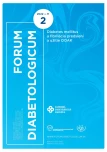The need for early intensification of therapy in type 2 diabetes patients with suboptimal glycaemic control
Authors:
Peter Novodvorský 1,2,3
Authors‘ workplace:
metabolické centrum s. r. o., Trenčín
1; Centrum diabetologie IKEM, Praha
2; Department of Oncology and Metabolism, Medical School, University of Sheffield, United Kingdom
3
Published in:
Forum Diab 2022; 11(2): 113-116
Category:
Overview
The progressive, not static nature of the course of type 2 diabetes mellitus (T2DM) predisposes this disease to regular monitoring and adjustment (intensification) of therapy. The goal is optimal glycaemic control at all times. In this article, I present the rationale for optimal glycaemic compensation and early intervention in the management of T2DM. I discuss the causal relationship of glycaemic compensation and risk of diabetic complications, the effect of metabolic memory, and clinical inertia, with a focus on decision making for further therapy intensification in the setting of poorly compensated T2DM on oral antidiabetic agents and basal insulin. Fixed-ratio combinations of basal insulins and GLP-1 receptor agonists positively affect 7 of the 8 pathological processes of the ominous octet, and thus represent the preferred choice in such situations. Recent clinical trials also provide evidence for their use as first-line insulin-based therapy.
Keywords:
type 2 diabetes – clinical inertia – IDegLira – insulin therapy – treatment intensification
Sources
1. Davies MJ, D’Alessio DA, Fradkin J et al. Management of Hyperglycemia in Type 2 Diabetes, 2018. A Consensus Report by the American Diabetes Association (ADA) and the European Association for the Study of Diabetes (EASD). Diabetes Care 2018; 41(12): 2669–2701. Dostupné z DOI: <http://dx.doi.Org/10.2337/dci18–0033>.
2. Brownlee M. The pathobiology of diabetic complications: a unifying mechanism. Diabetes. 2005; 54(6): 1615–1625. Dostupné z DOI: <http://dx.doi.org/10.2337/diabetes.54.6.1615>.
3. Nathan DM, Genuth S, Lachin J et al. [Diabetes Control and Complications Trial Research Group]. The effect of intensive treatment of diabetes on the development and progression of long-term complications in insulin-dependent diabetes mellitus. N Engl J Med 1993; 329(14): 977–986. Dostupné z DOI: <http://dx.doi.org/10.1056/NEJM199309303291401>.
4. Intensive blood-glucose control with sulphonylureas or insulin compared with conventional treatment and risk of complications in patients with type 2 diabetes (UKPDS 33). UK Prospective Diabetes Study (UKPDS) Group. Lancet 1998; 352(9131): 837–853. Erratum in Lancet 1999;354(9178): 602.
5. Nathan DM, Cleary PA, Backlund JY et al. Intensive diabetes treatment and cardiovascular disease in patients with type 1 diabetes. N Engl J Med 2005; 353(25): 2643–2653. Dostupné z DOI: <http://dx.doi.org/10.1056/NEJMoa052187>.
6. Testa R, Bonfigli AR, Prattichizzo F et al. The “Metabolic Memory” Theory and the Early Treatment of Hyperglycemia in Prevention of Diabetic Complications. Nutrients 2017; 9(5): 437. Dostupné z DOI: <http://dx.doi.org/10.3390/nu9050437>.
7. Draznin B, Aroda VR, Bakris G et al. [American Diabetes Association Professional Practice Committee]. 6. Glycemic Targets: Standards of Medical Care in Diabetes-2022. Diabetes Care 2022; 45(Suppl 1): S83-S96. Dostupné z DOI: <http://dx.doi.org/10.2337/dc22-S006>.
8. Martinka E, Mokáň M, Rašlová K et al. Interdisciplinárne odporúčania pre diagnostiku a liečbu diabetes mellitus, jeho komplikácií a najvýznamnejších sprievodných ochorení – 2021. Forum Diab 2021; 10(Suppl. 2).
9. O’Connor PJ, Sperl-Hillen JAM, Johnson PE et al. Clinical Inertia and Outpatient Medical Errors. In: Henriksen K, Battles JB, Marks ES et al (eds). Advances in Patient Safety: From Research to Implementation (Volume 2: Concepts and Methodology). Agency for Advances in Patient Safety: Rockville (MD) 2005.
10. Khunti K, Nikolajsen A, Thorsted BL et al. Clinical inertia with regard to intensifying therapy in people with type 2 diabetes treated with basal insulin. Diabetes Obes Metab 2016; 18(4): 401–409. Dostupné z DOI: <http://dx.doi.org/10.1111/dom.12626>.
11. Martinka E. Výber liečby do dvojkombinácie pri nedostatočnej liečbe metformínom samotným: výsledky štúdie DiaSTATUS-2. Forum Diab 2019; 8(2): 117–127.
12. Defronzo RA. Banting Lecture. From the triumvirate to the ominous octet: a new paradigm for the treatment of type 2 diabetes mellitus. Diabetes 2009; 58(4): 773–795. Dostupné z DOI: <http://dx.doi.org/10.2337/db09–9028>.
13. Novodvorsky P, Haluzik M. An update on the safety of insulin-GLP-1 receptor agonist combinations in type 2 diabetes mellitus. Expert Opin Drug Saf 2022; 21(3): 349–361. Dostupné z DOI: <http://dx.doi.org/10.1080/14740338.2021.1978974>.
14. Marso SP, Daniels GH, Brown-Frandsen K et al. Liraglutide and Cardiovascular Outcomes in Type 2 Diabetes. N Engl J Med 2016; 375(4): 311–322. Dostupné z DOI: <http://dx.doi.org/10.1056/NEJMoa1603827>.
15. Marso SP, McGuire DK, Zinman B et al. Efficacy and Safety of Degludec versus Glargine in Type 2 Diabetes. N Engl J Med 2017; 377(8): 723–732. Dostupné z DOI: <http://dx.doi.org/10.1056/NEJMoa1615692>.
16. Billings LK, Doshi A, Gouet D et al. Efficacy and Safety of IDegLira Versus Basal-Bolus Insulin Therapy in Patients With Type 2 Diabetes Uncontrolled on Metformin and Basal Insulin: The DUAL VII Randomized Clinical Trial. Diabetes Care 2018; 41(5): 1009–1016. Dostupné z DOI: <http://dx.doi.org/10.2337/dc17–1114>.
17. Lingvay I, Perez Manghi F, Garcia-Hernandez P et al. Effect of Insulin Glargine Up-titration vs Insulin Degludec/Liraglutide on Glycated Hemoglobin Levels in Patients With Uncontrolled Type 2 Diabetes: The DUAL V Randomized Clinical Trial. JAMA 2016; 315(9): 898–907. Dostupné z DOI: <http://dx.doi.org/10.1001/jama.2016.1252>.
18. Aroda VR, Gonzalez-Galvez G, Gron R et al. Durability of insulin degludec plus liraglutide versus insulin glargine U100 as initial injectable therapy in type 2 diabetes (DUAL VIII): a multicentre, open-label, phase 3b, randomised controlled trial. Lancet Diabetes Endocrinol. 2019; 7(8): 596–605. Dostupné z DOI: <http://dx.doi.org/10.1016/S2213–8587(19)30184–6>.
Labels
Diabetology Endocrinology Internal medicineArticle was published in
Forum Diabetologicum

2022 Issue 2
Most read in this issue
- Bleeding in patients on direct oral anticoagulants therapy: diagnostic-therapeutic management
- Laboratory monitoring of the treatment with direct oral anticoagulants
- Rivaroxaban in patients with diabetes mellitus and atrial fibrillation
- Diabetes mellitus and atrial fibrillation
